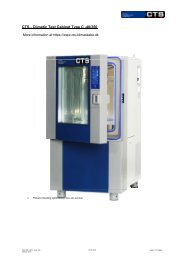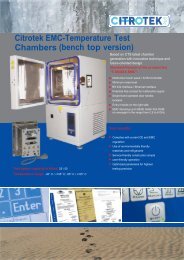High Speed Corroder 512 brochure 202UK - Citrotek
Citrotek ApS is proud to announce the introducing of the world's first stand-alone HACT cabinet; we call it the "High Speed Corroder" or just HSC 512. Sold and manufactured by www.cts-klimaskabe.dk
Citrotek ApS is proud to announce the introducing of the world's first stand-alone HACT cabinet; we call it the "High Speed Corroder" or just HSC 512. Sold and manufactured by www.cts-klimaskabe.dk
You also want an ePaper? Increase the reach of your titles
YUMPU automatically turns print PDFs into web optimized ePapers that Google loves.
HIGH SPEED CORRODER ‐ HSC <strong>512</strong><br />
HSC <strong>512</strong> (<strong>High</strong> <strong>Speed</strong> <strong>Corroder</strong>) is a salt<br />
spray test tool which accelerates<br />
corrosion on test specimens and surfaces.<br />
<strong>High</strong> <strong>Speed</strong> <strong>Corroder</strong> model HSC <strong>512</strong><br />
The method is known as ”<strong>High</strong>ly Accelerated Corrosion<br />
Test” or just HACT. This method is based on the same basic<br />
idea as HALT (<strong>High</strong>ly Accelerated Life Test) where a test<br />
specimen is subjected to a stepwise stress test until its<br />
destruction. It is therefore a relative robustness test.<br />
By using HALT weaknesses are identified in a few hours,<br />
thus preventing problems which would otherwise not have<br />
materialised for months or years.<br />
HACT has the same properties with respect to surfaces,<br />
metals and test specimens with a capillary effect. Corrosion<br />
and damage which it would otherwise take months to<br />
provoke with traditional salt spray testing, can be produced<br />
in a single week or a few weeks with HSC <strong>512</strong>.<br />
When using the HACT method, products can be tested for<br />
corrosion and capillary damage already during product<br />
development phase and a need for an alternative solution<br />
can be found within a short time. Exposed metals, sealing,<br />
combinations of different metals and crevice corrosion etc.<br />
are factors which can now be tested already at the<br />
prototype stage.<br />
The HSC <strong>512</strong> corrosion chamber uses technologies which<br />
enable integration of all the components for accelerated<br />
corrosion into one independent chamber. This makes it<br />
possible to apply the HACT technology in‐house without<br />
using extern heating source, compressed air or air<br />
extraction system, thus obtaining the effect of decades of<br />
corrosion in just a few weeks, and with HSC <strong>512</strong> this can be<br />
done in the company’s own facilities.<br />
HACT and HSC <strong>512</strong> cannot and should not replace the more<br />
traditional corrosion and salt spray tests. The main reason<br />
for this is that there is no internationally recognised HACT<br />
profile or standard ‐ the value lies primarily in the<br />
comparison of results from several identical tests, where<br />
the test specimen has been improved between each course<br />
of HACT sequence.<br />
Description of the typical HACT cycle<br />
The test specimen is sprayed with a salt brine solution for<br />
5‐15 minutes. The test specimen is then dried for 60<br />
minutes at a relatively high temperature. Dehumidification<br />
is ensured by low air humidity, typically 95%rh at minimum +70°C while still maintaining high<br />
convection. The duration of this stage is approx. 5 hours,<br />
which means that a full cycle can be completed in approx. 6<br />
hours.<br />
The cycle starts over and during the next spraying the test<br />
specimen is chocked with relatively cold water, which<br />
stimulates the capillary and corrosion weaknesses in the<br />
structure.<br />
The HACT cycle is usually repeated 4 times, which<br />
corresponds to 24 hours. The test specimen is then<br />
removed and inspected for any damage. When<br />
documentation has been obtained, usually by thorough<br />
photographing of problem areas, the test specimen is put<br />
back into the <strong>High</strong> <strong>Speed</strong> <strong>Corroder</strong> for another full 24 hours<br />
of testing. This is repeated until the test specimen no longer<br />
displays any noticeable changes for each 24 hours of<br />
testing.<br />
It is important that the test provides repeatable results to<br />
be able to compare changes in a product. The HACT cycle<br />
runs a fixed program, which ensures that the same test<br />
conditions are applied for every test run. The test specimen<br />
may then subsequently be optimised and the quality of the<br />
new improvements is exposed by new testing and<br />
comparison of the test results from the various runs. Since<br />
HACT is not an exact science, times and test parameters are<br />
not locked in the above cycle. It will be possible to change<br />
these in order to adjust times/temperatur to the test<br />
specimen. It is, however, important that all tests to which<br />
the test specimen is subjected, are identical.<br />
<strong>Citrotek</strong> ApS ‐ Jespervej 50A ‐ 3400 Hillerød – Denmark ‐ Tel: +45 4824 3656 ‐ Fax: +45 4824 3628 ‐ salg@citrotek.dk ‐ www.citrotek.dk<br />
Rev. 2.02UK – Jan. 2017
HIGH SPEED CORRODER ‐ HSC <strong>512</strong><br />
Description of <strong>High</strong> <strong>Speed</strong> <strong>Corroder</strong>,<br />
model HSC <strong>512</strong><br />
The test chamber itself consists of six glass sides, of which<br />
five are heated. The door is made of insulating glass and<br />
two LED strips on each side of the door, ensure lighting in<br />
the test chamber. The test specimen is placed on a plastic<br />
grill so that the salt brine can run from the test specimen<br />
and back into the drain for the brine container.<br />
Control unit<br />
A PLC controls the cycle and adjusts the temperature and<br />
humidity in the chamber. The process is created, started<br />
and stopped on a HSC touch display. This display also shows<br />
the current data such as temperature, humidity and time<br />
remaining for the relevant job etc. When the job has been<br />
completed, data can be extracted and included as<br />
documentation or comparison to other tests.<br />
Technical specifications:<br />
Contactless magnetically coupled fan wheel<br />
Air circulation is provided by a fan wheel with magnetic<br />
contactless motor coupling. The fan helps to oxidize the<br />
corrosion process and guarantees a homogenous<br />
environment in the test space. A port hole with a size of<br />
ø50 mm in the top left side, allows the user to insert cables<br />
and connections to the test subject if needed.<br />
When used correctly, the test chamber is virtually airtight<br />
and no salty fumes leak to the surroundings. There is<br />
therefore no risk of corrosion for the room and other<br />
equipment in close proximity of the HSC <strong>512</strong>.<br />
Sprinkler system<br />
At the top of the test space, the salt brine is sprayed from a<br />
nozzle which evenly distributes the brine in the chamber.<br />
The pumping system is composed of diaphragm pumps,<br />
which are very well suited for the corrosive salt water.<br />
Salt water spray nozzle<br />
Chamber specification <strong>High</strong> <strong>Speed</strong> <strong>Corroder</strong> HSC <strong>512</strong><br />
Outer dimensions: H x B X D 1850 mm x 1200 mm x 910 mm<br />
Test space volume:<br />
<strong>512</strong> l made of glass<br />
Entry/cable port:<br />
Yes, ø50 mm on the left side<br />
Net weight:<br />
250 kg<br />
Mains voltage:<br />
3 x 400 Volt AC @ 50 Hz / 7 Amp<br />
Fault current protection: HPFI protection<br />
Daily power consumption: Approx. 16 kWh<br />
Test specimen specification Test specimen<br />
Size: H x B X D<br />
≤580 mm x 580 mm x 700 mm<br />
Weight:<br />
≤20 kg<br />
Cycle specification<br />
Test parameter<br />
Cycle temperature:<br />
70 ±1°K<br />
Test space convection: Yes, contactless<br />
Max. humidity during cycle: ≥95% rH<br />
Cycle time:<br />
Usually 6 hours<br />
Brine capacity:<br />
20 litres<br />
Salt brine solution: Usually 5%<br />
Service & Warranty<br />
The HSC <strong>512</strong> test cabinet is serviced when required. It is<br />
recommended that the unit is serviced twice annually by a<br />
qualified technician. Furthermore, the chamber can be<br />
returned to the manufacturer for main service every other<br />
year. Warranty is covered according to Danish law. In B2B<br />
trade; warranty is normally 12 months from invoice date.<br />
Wearing parts such as grill, door seal, fan, wheel and filters<br />
are not covered by this warranty.<br />
Consumption<br />
It is recommended to replace the brine container with the<br />
salt water solution for each completed HACT. There may<br />
potentially be precipitation of metallic chips, particles and<br />
other residue washed from the test specimen. To avoid<br />
cross‐contamination, which may result in unintended and<br />
false test results, the container with contents must<br />
therefore be replaced for each new HACT.<br />
Humidity control<br />
HSC <strong>512</strong> has a controlled and constant water level in the<br />
test space floor, which constitutes the humidity control.<br />
The humidity in the chamber is effectively controlled by<br />
adjusting the temperature of the water in the water level<br />
bath beneath the grill, measured and verified by a robust<br />
no‐maintenance capacitive humidity sensor.<br />
The container with salt for a 5% solution is delivered ready<br />
for replacement as a spare part. Just add 20 l.<br />
demineralised water to the new brine container and<br />
installed it in the designated place below the test space.<br />
The HSC <strong>512</strong> will automatic mix the brine solution at the<br />
first run.<br />
Technical data and description may be changed without<br />
prior notice.<br />
<strong>Citrotek</strong> ApS ‐ Jespervej 50A ‐ 3400 Hillerød – Denmark ‐ Tel: +45 4824 3656 ‐ Fax: +45 4824 3628 ‐ salg@citrotek.dk ‐ www.citrotek.dk<br />
Rev. 2.02UK – Jan. 2017







